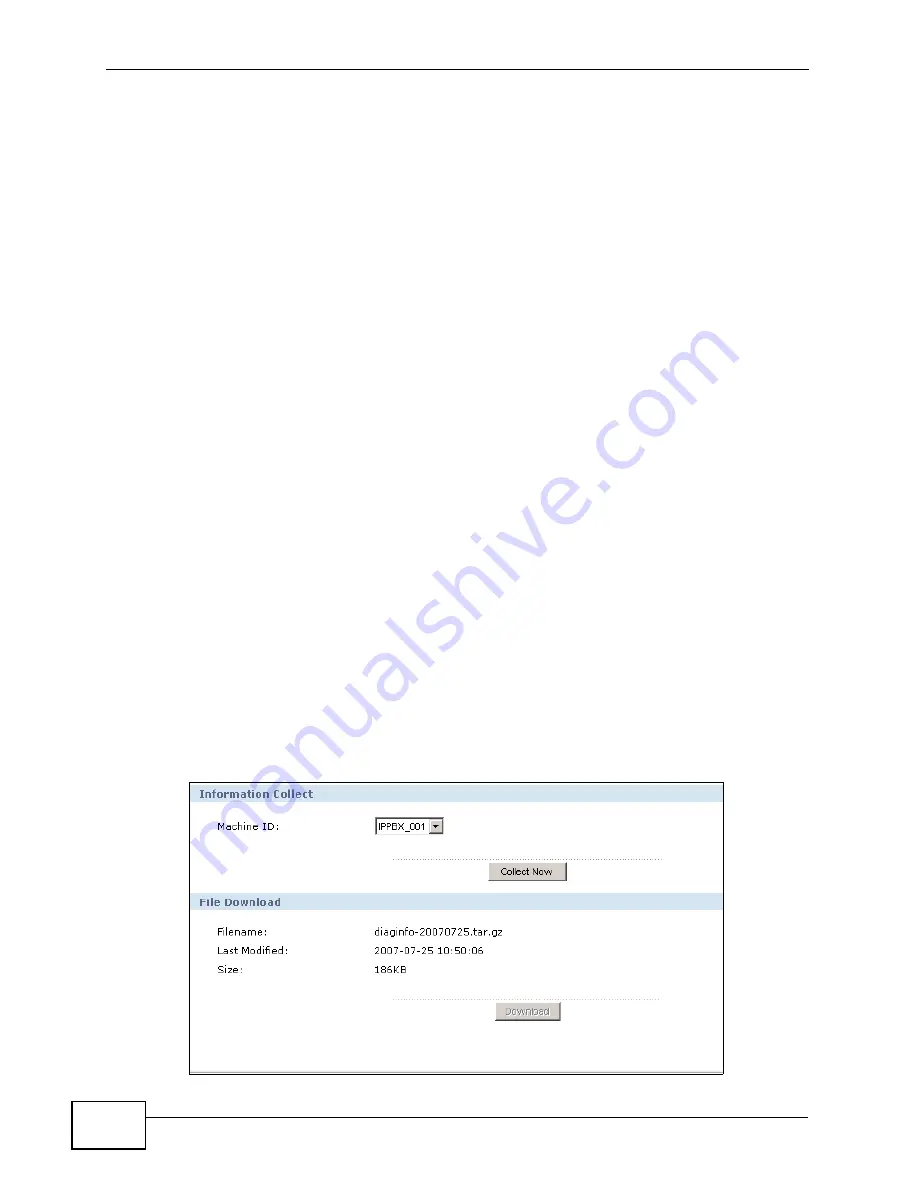
Chapter 30 Diagnostics
X2002 User’s Guide
418
• Current status information - the X2002 executes debugging commands and
saves the results in a compressed file. You can then submit the results to a
service technician or view some of the results via a spreadsheet application (for
example, Excel or WordPad). See the CLI Reference Guide for more information
on the commands executed to collect current status information. The resulting
file can be decompressed with data compression utilities, for example, WinRAR.
The resulting decompressed files are:
•
diag.ezsh.dbg
- contains the results of executing diagnostic and debug log
commands on the X2002. This file can be opened using a spreadsheet
application such as Excel or a text editor such as WordPad.
• system.bin
- contains encrypted information which can only be diagnosed by
a service engineer. Customer support may ask you to submit this file for
diagnostic purposes.
• Network traffic information - the X2002 logs traffic passing through its
interfaces. You can specify the interface, protocol or a specific host from which
to capture the traffic. The logs are saved in a Generic Network Capture
Document (
.cap
file extension) and can be viewed via a network analyzer such
as Ethereal. These files can diagnose communication problems between the
X2002 and other network devices. A service technician may ask you to perform
a packet capture when troubleshooting connectivity problems on your network.
30.2 The Information Collect Screen
Use this screen to capture running configuration details on the X2002 and save
them in compressed file format on your computer. A service technician may
request that you send this file for troubleshooting. This feature is for a debug
administrator and full administrator only (see
Click
Maintenance
>
Administration
>
Diagnostics
>
Information Collect
to
view the screen as shown.
Figure 248
Diagnostics > Information Collect
Summary of Contents for X2002
Page 2: ......
Page 24: ...Table of Contents X2002 User s Guide 24...
Page 25: ...25 PART I User s Guide...
Page 26: ...26...
Page 40: ...Chapter 2 How It Works X2002 User s Guide 40...
Page 99: ...99 PART II Technical Reference...
Page 100: ...100...
Page 124: ...Chapter 5 Network Deployment X2002 User s Guide 124...
Page 166: ...Chapter 7 Auto Provision X2002 User s Guide 166...
Page 170: ...Chapter 8 QoS X2002 User s Guide 170...
Page 248: ...Chapter 16 Click To Talk Group X2002 User s Guide 248...
Page 252: ...Chapter 17 Group Access Code X2002 User s Guide 252...
Page 304: ...Chapter 19 Auto Attendant X2002 User s Guide 304...
Page 312: ...Chapter 20 LCR X2002 User s Guide 312...
Page 346: ...Chapter 22 Call Services X2002 User s Guide 346...
Page 380: ...Chapter 25 Status Observation X2002 User s Guide 380...
Page 402: ...Chapter 27 Call Detail Record CDR X2002 User s Guide 402...
Page 410: ...Chapter 28 ACD Logs X2002 User s Guide 410...
Page 416: ...Chapter 29 Administrator Accounts X2002 User s Guide 416...
Page 424: ...Chapter 30 Diagnostics X2002 User s Guide 424...
Page 426: ...Chapter 31 X2002 User s Guide 426...
Page 446: ...Chapter 32 Remote Management X2002 User s Guide 446...
Page 448: ...Chapter 33 TFTP Management X2002 User s Guide 448...
Page 462: ...Chapter 35 License Control X2002 User s Guide 462...
Page 482: ...Chapter 36 Web Portal X2002 User s Guide 482...
Page 508: ...Chapter 39 Product Specifications X2002 User s Guide 508...
Page 548: ...Appendix C Legal Information X2002 User s Guide 548...
Page 562: ...Index X2002 User s Guide 562...




































